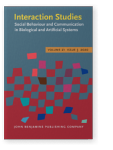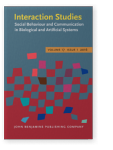Alban Lemasson
List of John Benjamins publications for which Alban Lemasson plays a role.
2020 Public attitude influences actors’ visual orientation: A pilot experimental study Interaction Studies 21:3, pp. 428–439 | Article
Human emotions guide verbal and non-verbal behaviour during social encounters. During public performances, performers’ emotions can be affected directly by an audience’s attitude. The valence of the emotional state (positive or negative) of a broad range of animal species is known to be… read more
2016 Voice features of telephone operators predict auditory preferences of consumers Interaction Studies 17:1, pp. 77–97 | Article
What makes a human voice agreeable is a matter of scientific discussion. Whereas prosody was shown to play a role regarding “male-female” attraction, the impact of frequency modulations in “non-sexual”, notably commercial, contexts has attracted little attention. Another point unaddressed in the… read more
2011 What can forest guenons “tell” us about the origin of language? Primate Communication and Human Language: Vocalisation, gestures, imitation and deixis in humans and non-humans, Vilain, Anne, Jean-Luc Schwartz, Christian Abry and Jacques Vauclair (eds.), pp. 39–70 | Article
Human language is by far the most elaborated communication system, but talking, like any behaviour, has not left any clear physical signs of its evolution. Although plausible but quantitatively limited explanations can be drawn from archaeological studies, we will probably never find real direct… read more
2009 The primate roots of human language: Primate vocal behaviour and cognition in the wild Becoming Eloquent: Advances in the emergence of language, human cognition, and modern cultures, d'Errico, Francesco and Jean-Marie Hombert (eds.), pp. 235–266 | Article
Our research describes the natural communication in different primates, as well as their underlying cognitive abilities. We are interested in the communication skills and social cognition of monkeys and apes in their natural habitats. For this purpose, we observe wild groups in Africa and Asia… read more



